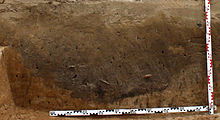Garbage pit

Garbage pits are a genus of archaeological sources. They are pits in the earth that were apparently created for the dumping of organic and other material that is of waste character for the scientists.
archeology
Waste pits on archaeological sites are pits that contain so-called municipal waste. The found material seems to be based on a projection of the modern understanding of waste.
From Neolithic and Bronze Age pile-dwelling settlements, it has been proven that objects primarily understood as food waste in the immediate vicinity of the settlement were thrown into water bodies.
interpretation
However, there are alternative interpretations for garbage pits:
- Along the long houses of the Early Neolithic and Middle Neolithic (for example, Bandkeramik and Rössen culture ) there were pits for the extraction of clay ("Lehentnahmepuben") to seal the braided walls of the houses. In the Lengyel culture , there were pits for extraction from the clay that were not directly next to the house.
- Pits were used to store supplies into which rubbish came - also by chance - during natural backfilling (sedimentation).
- Ritual dumping in settlement pits is also discussed, especially for the Iron Age .
- In English archeology, deliberate deposition in pits is also increasingly being discussed ( structured deposition ).
Evidence of all practices is difficult. The phenomenon of ritual laying down of selected attributes (for example skull and skeleton parts, ceramics, tools, idol figures, etc.) is known in Central Europe from pits of the younger linear ceramics and the Michelsberg culture . In the case of interrupted earthworks ( causewayed enclosures ), i.e. pits systematically and in a certain form, such a deposition is easier to detect, but the deposited objects are hardly likely to have been waste. Many of these pits are located near cult sites. The “rubbish” found in pits in “uninhabited” but elevated Michelsberg earthworks can hardly have been brought from the valley to the mountain for mundane disposal.
The disposal of organic waste is not found in recent cultures outside of the western industrial nations.
present
Today waste disposal is a must. Landfills are used for this in most European countries . These can be created in sinks . In many countries, including Germany, the use of a (privately created) waste pit is prohibited and made a criminal offense.
See also
literature
- J. Chapman: Pit-digging and structured deposition in the Neolithic and Copper Age of central and eastern Europe. In: Proceedings of the Prehistoric Society . Volume 66, 2000, 61-87.
- Jan Harding: Pit-digging, occupation and structures deposition on Rudston Wold, Eastern Yorkshire. In: Oxford Journal of Archeology . Volume 25, No. 2, 2006, 109-126.
- Joshua Pollard: Inscribing space: formal deposition at the later Neolithic monument of Woodhenge, Wiltshire. In: Proceedings of the Prehistoric Society. Volume 61, 1995, 137-156.
- Joshua Pollard: The aesthetics of depositional practice. In: World Archeology . Volume 33, No. 2, 2001, 315-333.
- Colin Richards, Julian Thomas: Ritual activity and structured deposition in later Neolithic Wessex. In: Richard Bradley , J. Gardiner (Eds.): Neolithic Studies. A Review of Some Current Research. Oxford, British Archaeological Reports 133, 1984, 189-218.
Web links
Individual evidence
- ↑ U. Sommer: Cultural attitudes to dirt and waste and their effects on archaeological interpretation. In: Archaeological Reports. Volume 11, 1998, pp. 41-54.
- ↑ Hornstaad-Hörnle: settlement archeology in the Alpine foothills. Research and reports on prehistory and early history in Baden-Württemberg 98. Stuttgart, Theiss 2006.
- ^ H. Stäuble: The findings. In: Jens Lüning (Hrsg.): A settlement site for the oldest band ceramics in Bruchenbrücken, City of Friedberg / Hessen. University research on prehistoric archeology 39. Bonn, Habelt, 1997.
- ^ JD Hill: Ritual and rubbish in the Iron Age of Wessex: a study on the formation of a specific archaeological record. BAR British series 242. Oxford, Tempus Reparatum 1995.